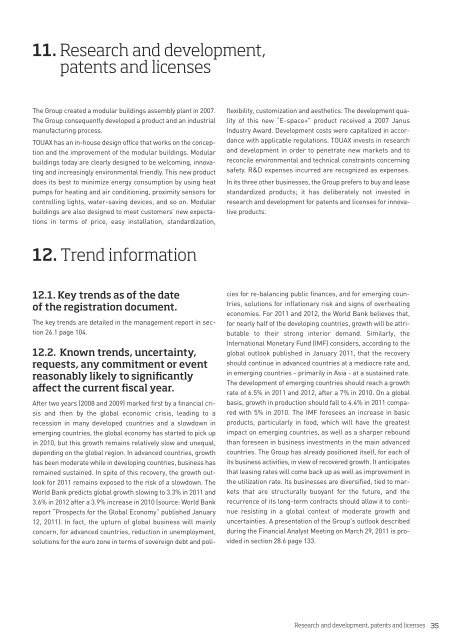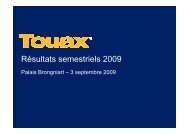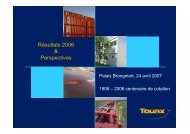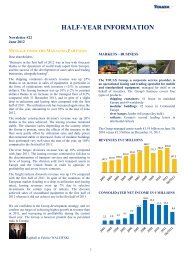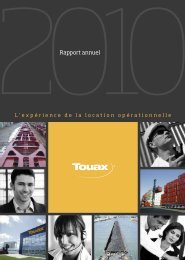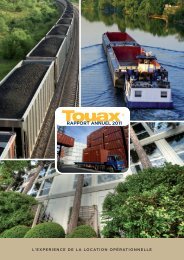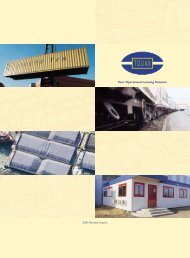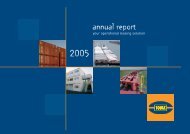2010 annual report - touax group
2010 annual report - touax group
2010 annual report - touax group
You also want an ePaper? Increase the reach of your titles
YUMPU automatically turns print PDFs into web optimized ePapers that Google loves.
11. Research and development,<br />
patents and licenses<br />
The Group created a modular buildings assembly plant in 2007.<br />
The Group consequently developed a product and an industrial<br />
manufacturing process.<br />
TOUAX has an in-house design office that works on the conception<br />
and the improvement of the modular buildings. Modular<br />
buildings today are clearly designed to be welcoming, innovating<br />
and increasingly environmental friendly. This new product<br />
does its best to minimize energy consumption by using heat<br />
pumps for heating and air conditioning, proximity sensors for<br />
controlling lights, water-saving devices, and so on. Modular<br />
buildings are also designed to meet customers’ new expectations<br />
in terms of price, easy installation, standardization,<br />
flexibility, customization and aesthetics. The development quality<br />
of this new “E-space+" product received a 2007 Janus<br />
Industry Award. Development costs were capitalized in accordance<br />
with applicable regulations. TOUAX invests in research<br />
and development in order to penetrate new markets and to<br />
reconcile environmental and technical constraints concerning<br />
safety. R&D expenses incurred are recognized as expenses.<br />
In its three other businesses, the Group prefers to buy and lease<br />
standardized products; it has deliberately not invested in<br />
research and development for patents and licenses for innovative<br />
products.<br />
12. Trend information<br />
12.1. Key trends as of the date<br />
of the registration document.<br />
The key trends are detailed in the management <strong>report</strong> in section<br />
26.1 page 104.<br />
12.2. Known trends, uncertainty,<br />
requests, any commitment or event<br />
reasonably likely to significantly<br />
affect the current fiscal year.<br />
After two years (2008 and 2009) marked first by a financial crisis<br />
and then by the global economic crisis, leading to a<br />
recession in many developed countries and a slowdown in<br />
emerging countries, the global economy has started to pick up<br />
in <strong>2010</strong>, but this growth remains relatively slow and unequal,<br />
depending on the global region. In advanced countries, growth<br />
has been moderate while in developing countries, business has<br />
remained sustained. In spite of this recovery, the growth outlook<br />
for 2011 remains exposed to the risk of a slowdown. The<br />
World Bank predicts global growth slowing to 3.3% in 2011 and<br />
3.6% in 2012 after a 3.9% increase in <strong>2010</strong> (source: World Bank<br />
<strong>report</strong> “Prospects for the Global Economy” published January<br />
12, 2011). In fact, the upturn of global business will mainly<br />
concern, for advanced countries, reduction in unemployment,<br />
solutions for the euro zone in terms of sovereign debt and policies<br />
for re-balancing public finances, and for emerging countries,<br />
solutions for inflationary risk and signs of overheating<br />
economies. For 2011 and 2012, the World Bank believes that,<br />
for nearly half of the developing countries, growth will be attributable<br />
to their strong interior demand. Similarly, the<br />
International Monetary Fund (IMF) considers, according to the<br />
global outlook published in January 2011, that the recovery<br />
should continue in advanced countries at a mediocre rate and,<br />
in emerging countries - primarily in Asia - at a sustained rate.<br />
The development of emerging countries should reach a growth<br />
rate of 6.5% in 2011 and 2012, after a 7% in <strong>2010</strong>. On a global<br />
basis, growth in production should fall to 4.4% in 2011 compared<br />
with 5% in <strong>2010</strong>. The IMF foresees an increase in basic<br />
products, particularly in food, which will have the greatest<br />
impact on emerging countries, as well as a sharper rebound<br />
than foreseen in business investments in the main advanced<br />
countries. The Group has already positioned itself, for each of<br />
its business activities, in view of recovered growth. It anticipates<br />
that leasing rates will come back up as well as improvement in<br />
the utilization rate. Its businesses are diversified, tied to markets<br />
that are structurally buoyant for the future, and the<br />
recurrence of its long-term contracts should allow it to continue<br />
resisting in a global context of moderate growth and<br />
uncertainties. A presentation of the Group's outlook described<br />
during the Financial Analyst Meeting on March 29, 2011 is provided<br />
in section 28.6 page 133.<br />
Research and development, patents and licenses<br />
35


